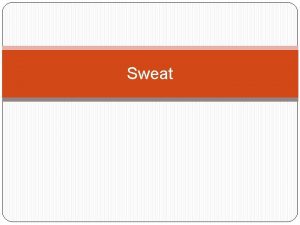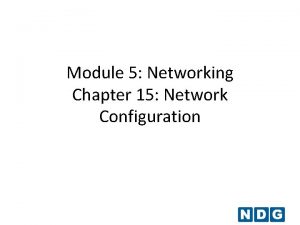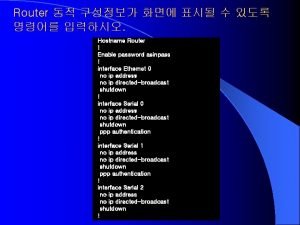date hostname uname who ls clear passwd 3



































![후면 처리 예 l l $ (sleep 100; echo done) & [1] 8320 $ 후면 처리 예 l l $ (sleep 100; echo done) & [1] 8320 $](https://slidetodoc.com/presentation_image_h2/ae0fd873cdb962c7cc13cc2234c0ff78/image-36.jpg)







- Slides: 43



간단한 명령어 사용 $ date $ hostname $ uname $ who $ ls $ clear $ passwd 3








디렉터리 리스트 l $ ls –l -l(long) -rw-r--r-- 1 chang faculty 2088 4월 16일 13: 37 cs 1. txt l $ ls –asl 총 10 2 drwxr-xr-x 2 chang faculty 512 4월 16일 13: 37. 2 drwxr-xr-x 3 chang faculty 512 4월 16일 13: 37. . 6 -rw-r--r-- 1 chang faculty 2088 4월 16일 13: 37 cs 1. txt 11






cp 명령어 l $ cp 파일 1 파일 2 파일 1의 복사본 파일 2를 현재 디렉터리 내에 만듬 $ cp cs 1. txt cs 2. txt $ ls -l cs 1. txt cs 2. txt -rw-r--r-- 1 chang faculty 2088 4월 16일 13: 37 cs 1. txt -rw-r--r-- 1 chang faculty 2088 4월 16일 13: 45 cs 2. txt l $ cp 파일 디렉터리 파일 1의 복사본을 디렉터리 내에 만듬 $ cp cs 1. txt /tmp 17

mv 명령어 l mv(move) 파일 1의 이름을 파일 2로 변경한다. $ mv 파일 1 파일 2 $ mv cs 2. txt cs 3. txt $ ls -l -rw-r--r-- 1 chang faculty 2088 4월 16일 13: 37 cs 1. txt -rw-r--r-- 1 chang faculty 2088 4월 16일 13: 56 cs 3. txt l 파일을 디렉터리 내로 이동 $ mv 파일 디렉터리 $ mv cs 3. txt /tmp 18




파일 속성(file attribute) l 파일의 이름, 타입, 크기, 소유자, 사용권한, 수정 시간 $ ls -sl cs 1. txt 6 -rw-r--r-- 1 chang faculty 2088 4월 16일 13: 37 cs 1. txt 22







출력 재지정 예 l $ cat > list 1. txt Hi ! This is the first list. ^D l $ cat > list 2. txt Hello ! This is the second list. ^D l $ cat list 1. txt list 2. txt > list 3. txt l $ cat list 3. txt Hi ! This is the first list. Hello ! This is the second list. 29

출력 추가 l 명령어의 표준출력을 모니터 대신에 기존 파일에 추가 $ 명령어 >> 파일 $ cat >> list 1. txt Bye ! This is the end of the first list. ^D $ cat list 1. txt Hi ! This is the first list. Bye ! This is the end of the first list. 30





![후면 처리 예 l l sleep 100 echo done 1 8320 후면 처리 예 l l $ (sleep 100; echo done) & [1] 8320 $](https://slidetodoc.com/presentation_image_h2/ae0fd873cdb962c7cc13cc2234c0ff78/image-36.jpg)
후면 처리 예 l l $ (sleep 100; echo done) & [1] 8320 $ find. -name test. c -print & [2] 8325 $ jobs [1] + Running ( sleep 100; echo done ) [2] - Running find. -name test. c –print $ fg %작업번호 $ fg %1 ( sleep 100; echo done ) l 후면처리 입출력 $ find. -name test. c -print > find. txt & $ find. -name test. c -print | mail chang & $ wc < inputfile & 36

프로세스(process) l l l 실행중인 프로그램을 프로세스(process)라고 부른다. 각 프로세스는 유일한 프로세스 번호 PID를 갖는다. ps 명령어를 사용하여 나의 프로세스들을 볼 수 있다. $ ps PID TTY TIME CMD 8695 pts/3 00: 00 csh 8720 pts/3 00: 00 ps $ ps u USER PID %CPU %MEM VSZ RSS TTY STAT START TIME COMMAND chang 8695 0. 0 5252 1728 pts/3 Ss 11: 12 0: 00 -csh chang 8793 0. 0 4252 940 pts/3 R+ 11: 15 0: 00 ps u 37

ps aux $ ps aux USER PID %CPU %MEM VSZ RSS TTY STAT START TIME COMMAND root 1 0. 0 2064 652 ? Ss 2011 0: 27 init [5] root 2 0. 0 0 0 ? S< 2011 0: 01 [migration/0] root 3 0. 0 0 0 ? SN 2011 0: 00 [ksoftirqd/0] root 4 0. 0 0 0 ? S< 2011 0: 00 [watchdog/0]. . . root 8692 0. 0 0. 1 9980 2772 ? Ss 11: 12 0: 00 sshd: chang [pr chang 8694 0. 0 9980 1564 ? R 11: 12 0: 00 sshd: chang@pts chang 8695 0. 0 5252 1728 pts/3 Ss 11: 12 0: 00 -csh chang 8976 0. 0 4252 940 pts/3 R+ 11: 24 0: 00 ps aux 38





 Hostname tizen
Hostname tizen All of the following accurately describe hadoop
All of the following accurately describe hadoop Record date ex dividend date
Record date ex dividend date Eligibility for dividend
Eligibility for dividend Nice ibs
Nice ibs What is smear layer
What is smear layer Bar mise en place checklist
Bar mise en place checklist Clear clasp
Clear clasp Clear stream
Clear stream Glclampf
Glclampf Colonoscopy diet sheet
Colonoscopy diet sheet Crystal clear software
Crystal clear software Clear thinking and writing
Clear thinking and writing Flip flop jk com preset e clear
Flip flop jk com preset e clear Aim for clearer messages warming
Aim for clearer messages warming Clear air
Clear air Distinct ideas
Distinct ideas Punctuation marks make meaning clear.
Punctuation marks make meaning clear. Clearway steam inhaler
Clearway steam inhaler Clear liquid diet foods
Clear liquid diet foods Which modifier can be used in the comparative degree?
Which modifier can be used in the comparative degree? A clear concise document which outlines preventive
A clear concise document which outlines preventive Clear perinatal quality
Clear perinatal quality The difference between right and wrong is clear
The difference between right and wrong is clear Clear salty liquid
Clear salty liquid A clear understanding
A clear understanding Hd clear kit
Hd clear kit Robert gunning principles of clear writing
Robert gunning principles of clear writing The yellowish liquid portion of blood
The yellowish liquid portion of blood Clear zone chart
Clear zone chart Medicine to clear stool
Medicine to clear stool Difference between one & two way slab
Difference between one & two way slab Matlab clear
Matlab clear Mathematica
Mathematica Alternate rebellion dbt
Alternate rebellion dbt Clear console matlab
Clear console matlab Is having a clear perception of your personality
Is having a clear perception of your personality Clear the blue dots
Clear the blue dots A clear pleasantly flavoured sweetened hydroalcoholic
A clear pleasantly flavoured sweetened hydroalcoholic It came upon a midnight clear images
It came upon a midnight clear images Bt ip clear
Bt ip clear Why is the colour of clear sky blue
Why is the colour of clear sky blue Clear nitrile gloves
Clear nitrile gloves Construction of clear sentences and paragraphs
Construction of clear sentences and paragraphs



































































